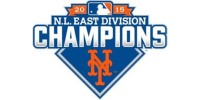Travis d’Arnaud
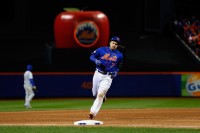
There is no more physically, psychologically, and intellectually demanding position than catcher.
The catcher needs to know the entire scouting report for the opposition at the plate and on the basepaths. The catcher needs to balance a hitter’s strength and weaknesses against his pitcher’s in calling a game. If a pitcher doesn’t have a pitch working, he has to create a new strategy on the fly. When a pitch is thrown, he has to do all he can to make sure the pitch is called a strike. Throughout the game, he has to keep the pitcher’s head in the game. It’s especially tough when the pitcher is getting squeezed.
When his team is up to bat, he needs to talk to the pitcher about the batters coming up the next inning. He needs to talk with the manager and pitching coach not only about that, but also how the pitcher is throwing and what he has left. By the way, at some point, he has to bat 4-4 times in a game to help put some runs on the board for the pitcher.
The catcher faces pitches in the dirt he has to eat up with any part of his body. He will get nicked with a foul tip or an errant swing. Runners try to take him out with a slide, or in very rare instances, he can get run over at home plate. The catcher is bound to have some bumps and bruises or trips to the DL. Even after a tough game, the catcher comes back and does it all tomorrow.
Even though all of this is gust the tip of the iceberg of a catcher’s responsibilities, how do most people judge the effectiveness of a catcher? Their effectiveness in throwing out potential base stealers.
It was the topic in John Harper’s New York Daily News column about Travis d’Arnaud‘s troubles throwing out baserunners in the postseason. Actually, to call it a difficulty is an understatement. Despite being better than league average in throwing out baserunners during the regular season, d’Arnaud struggled mightily in the postseason. Would be basestealers were a perfect 11/11 against him and the Mets pitching staff.
This was a major focus of Harper’s article. For his part, d’Arnaud readily admits that shouldn’t happen, and he says he needs to improve. It was an important enough issue for Terry Collins that he made it a point to take a part in the first throwing drills of Spring Training. There was talk of a need to improve d’Arnaud’s mechanics and the like.
What was overlooked was that of the 11 people who stole a base against the Mets in the postseason, only one scored a run. A big reason why is that d’Arnaud excels in all the other areas of being a catcher.
Since he became the Mets catcher, d’Arnaud has been an excellent pitch framer. Last year, he led the majors in highest percentage of balls being called strikes. When there is a premium being placed on the pitch counts and innings pitched for this young staff, every strike d’Arnaud can steal is crucial. Furthermore, getting strikes called puts a pitcher in an advantageous position. This usually leads to shorter at bats and more outs.
Additionally, there is the subjective element of catching. The pitchers like throwing to him. They feel comfortable while he’s behind the plate. He instills confidence in his staff.
By the way, he’s also a terrific hitter. He was the second best offensive catcher in baseball last year. In the NLCS, he hit a homerun off of the Homerun Apple. d’Arnaud hit it so hard, the apple needed a bandaid.
So overall, d’Arnaud does everything you could ever want your catcher to do. He has the confidence of his pitching staff. He gets the pitches called for strikes. He is a good hitter. Basically, d’Arnaud comes to beat you in multiple ways each and every day. If he struggles for a stretch with throwing out baserunners, there are other parts of his game that overshadow it, that help to prevent that run from scoring.
d’Arnaud may struggle throwing out people again next year. That’s fine. As long as he keeps doing what he’s doing, he will still be a terrific all-around catcher. He will help the Mets return to the postseason and win the World Series.
Editor’s Note: this article first appeared on metsmerizedonline.com
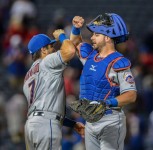
While the Mets have issues regarding their ability to extend their starting pitching, they have other areas to address as well. As it stands, the Mets may have around $97 million off the books by 2019. The Mets will need that money not just to re-sign pitching, but also to build their roster.
One key decision the Mets will have to make is at catcher. By 2019, Travis d’Arnaud will be a year away from free agency. Kevin Plawecki will be in either his first or second arbitration year around the same time.
As it stands going into the 2016 season, the team is best suited to have d’Arnaud starting with Plawecki as his backup. However, I do question if that arrangement is the best situation for the long term. It can be argued with the Mets going into this season with that arrangement, they risk the diminution of the trade value of either or both of these players. It’s a tough decision to make.
Travis d’Arnaud
d’Arnaud is a 27 year old catcher, who is presumably entering the prime of his career. He will be 31 when he becomes a free agent, assuming the Mets don’t work out an extension with him before that.
After working out his game in AAA in 2014, he seems to have fulfilled his offensive potential. When he returned, he hit .272/.319/.486 with 10 homers and 32 RBI in 69 games. He had a low BABIP of .287, which showed these numbers could get even better. They did in 2015. He hit .268/.340/.485 with 12 homeruns and 41 RBI in 67 games last year. He again had a low BABIP of .289. So there may still be room for improvement (assuming of course that the .287 – .289 BABIP is his natural level).
On top of these good and improving numbers, d’Arnaud has shown himself to be a good catcher. He was a highly rated pitch framer in 2014, and he was again in 2015. It’s important to get those extra strike calls to help reduce the pitches thrown by your pitching staff. In fact, d’Arnaud was the best at it last year. Despite his troubles in the World Series, d’Arnaud had an acceptable 32.6% rate of throwing out would be basestealers.
I understand there is more to catching than this, however the other things involved like blocking pitches in the dirt aren’t as quantifiable. Regardless, the most important thing for a catcher is to be a good receiver, and d’Arnaud has seemingly and statistically fine very well in that area.
Between d’Arnaud’s offensive and defensive abilities, you’d be hard pressed to find a reason not to extend d’Arnaud.
Unfortunately, there is a reason. Whether it’s fair or not, d’Arnaud is getting a reputation as injury prone. Last year, d’Arnaud had two freak contact injuries. In April, he broke his pinkie when he was hit by a pitch. When he returned from the DL, he suffered a hyper-extended elbow on a tag play. If that was it, I presume most teams would chalk it up to the freak nature of those injuries. However, he also had a number of injuries in the minors.
This year will be a big year for d’Arnaud. If he stays healthy, he’s primed for a big year; the type of year that will get him paid well in arbitration and free agency. If he gets injured again, he gives validity to the injury prone label thereby diminishing his arbitration and trade value.
Kevin Plawecki
Coming into the 2015 season, Plawecki was a well regarded prospect. Reflecting upon Plawecki’s 2015 season, it’s strange to think he was a highly regarded prospect more because of his bat than his glove.
Like d’Arnaud, Plawecki was exceptional in pitch framing last year. In fact, among big league catchers last year, he was second best. He was not as adept as d’Arnaud in throwing out baserunners. He only threw out 25.6% of basestealers. Given his needing to work on his footwork behind the plate, this should not come as a surprise. Unfortunately, the Mets losing Bob Geren is a hindrance because Geren was well regarded in his ability to work with catchers. That’s not to say Plawecki can’t improve.
Offensively, Plawecki is a different hitter than d’Arnaud. Whereas d’Arnaud has been seen as a power threat, Plawecki is seen as a gap to gap hitter. His offensive game was thought to be so advanced it was thought he could challenge d’Arnaud for playing time last year. That never happened. In part, that is because Plawecki had a tough rookie year.
In an admittedly weak Mets lineup, Plawecki hit a woeful .219/.280/.296 in 73 games. One could be further pessimistic about Plawecki’s offensive potential by looking to his AAA numbers. In AAA, in a hitter’s league, Plawecki only hit .262/.318/.392 over parts of two seasons. However, that’s not the full picture of Plawecki offensively.
Keep in mind, Plawecki only played 65 games in AAA, which is not a full season. Over the course of his minor league career, Plawecki was a much more palatable .290/.364/.432 hitter. Furthermore, while Plawecki’s major league numbers were lackluster, he had a low .277 BABIP. This suggests he’s due for an improvement at the plate next year. Overall, given how well regarded a prospect he is, it would be fair to presume Plawecki could be much better offensively next year.
We also don’t know what, if any effect, Plawecki’s sinus problems had last year. Plawecki admitted he felt dizzy during parts of last season. With his offseason surgery, and a year in the majors under his belt, Plawecki could be due for a much improved 2016.
The main thing holding him back will be d’Arnaud. As d’Arnaud’s backup, Plawecki will get limited reps at the plate hindering his ability to improve. Furthermore, with reduced playing time, Plawecki’s numbers can swing drastically. He’s as likely to have good numbers as he is to have poor numbers. Whichever way it goes, it’s likely to be a small sample size. With that said, if he has another poor offensive season, whether it’s driven by a low BABIP or not, it will be hard to unring that bell.
Another issue is Plawecki’s status as the backup catcher. While it’s understandable the Mets want Plawecki around to play a little more to help keep d’Arnaud healthy, it should be noted that this still makes Plawecki a backup catcher. While his status as a backup catcher will drive down his arbitration numbers, it will also drive down the return you may get for him in a trade.
Why Are They Both on the Roster
Simply put, d’Arnaud and Plawecki are both on the roster because it gives the Mets the best chance to win in 2016. The hope is that Plawecki can catch more frequently than your average backup to keep d’Arnaud fresh and healthy.
In addition, the Mets are contemplating letting both learn other positions to keep them both fresh and get them both enough at bats. It’s more important for Plawecki because he’s still a young prospect who needs at bats. d’Arnaud could also benefit because getting him out from behind the plate should keep him fresh over the course of the year.
As such, the Mets will need both in the majors. If they play it right, they could get good years from both while maintaining or improving their trade value. This could be Terry Collins biggest challenge in 2016.
d’Arnaud’s Potential Contract
Given the expense that will be incurred in locking up the Mets starting pitching, who the Mets keep may be driven by how expensive they will be.
Naturally, d’Arnaud’s value will vary depending upon his health. If d’Arnaud is healthy, the comp I would use for his contract is Russell Martin. When Martin signed his most recent free agent deal with the Blue Jays, he was coming off a career year where he hit .290/.402/.430. With that’s said, Martin was a career .259/.364/.399 hitter, and he was coming off his age 31 season. That is how old d’Arnaud will be when he becomes a free agent.
Now, d’Arnaud has hit for more power than Martin. However, Martin is more durable, and he has been seen as a leader. Martin has averaged 129 games behind the plate. d’Arnaud has not caught more than 108 in a season. However, assuming d’Anaud is healthy, you would envision him being a catcher who is comparable to Russell Martin, if not better. Accepting that premise, here is the breakdown of Martin’s contract:
- 2015: $7 million
- 2016: $15 million
- 2017: $20 million
- 2018: $20 million
- 2019: $20 million
Now, I’m not suggesting the Mets would or should give d’Arnaud a five year $82 million contract. Martin was a free agent, who could’ve signed with anyone. d’Arnaud loses some bargaining power by being arbitration eligible. If the Mets sought to enter into a deal with him, buying out some free agent years, his contract could reasonably look like this:
- 2018: $8 million – $10 million
- 2019: $10 million – $15 million
- 2020: $15 million – $20 million
- 2021: $15 million – $20 million
Assuming this is a fair and reasonable range, the Mets available money, assuming no increase in the payroll, would be between $82 million to $87 million to complete the roster.
Plawecki’s Cost
While d’Arnaud may cost the Mets between $10 – $20 million, Plawecki should cost less. If Plawecki remains with the club for all of 2016, he will likely become a Super Two player (assuming no changes to the CBA). As such, Plawecki would become arbitration eligible in 2019.
Now, if the Mets were smart about tinkering Plawecki’s service time, they could delay his arbitration eligibility until 2020. That would mean in 2019, the Mets would only need to pay him approximately $500-$600 thousand leaving the bulk of the $97 million to pay their starters and fill out the roster.
With that said, if you’re going to keep Plawecki, and make him the starter, you’re going to have to pay him eventually. Judging by typical arbitration figures, Plawecki could earn anywhere from $1 million to $5 million depending on playing time and production. If Plawecki becomes the starting catcher, and he’s productive, he would be at the higher end of the spectrum.
Depending on the decision the Mets make on Plawecki, that $97 million figure could be reduced to the range of $92 – $96 million.
The Decision
Selecting between d’Arnaud and Plawecki is no easy task. While d’Arnaud is more polished offensively and defensively, he is also three years older, and he has a long injury history. He is going to be a lot more expensive than Plawecki at the time the Mets starting pitchers will become free agents.
On the other hand, Plawecki is a well regarded prospect that has yet to produce in AAA or the majors. There is still time for him to fulfill his potential. However, that will be difficult with the Mets keeping him on as a backup limiting his at bats. The best course would be for the Mets to put him in AAA, manipulate his service time, and let him improve. It appears the Mets won’t do that.
No matter what the Mets do, the time to make the decision between d’Arnaud and Plawecki is fast approaching. Sooner or later, the Mets will have to choose between the two. In terms of preserving trade value that decision could be in 2016 or 2017, at the latest. In terms of cost, it appears 2019 is the last date. It would behoove the Mets to make the decision sooner rather than later to maximize the return they would get for either player.
Overall, while he may be much more expensive, and therefore a possible hindrance to re-signing a starter, I would keep d’Arnaud. He’s already shown himself to be an offensive force while being a good receiver. He’s a better bet to produce going forward than Plawecki.
Hopefully, he’s healthy enough to justify an extension, and Plawecki improves enough to become a big trade chip. Ultimately, that is the best case scenario for the Mets going forward.
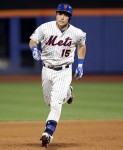
For one reason or another, Travis d’Arnaud switched uniform numbers with bench coach Bob Geren heading into the 2015 season. Now that Bob Geren has left the Mets for the Dodgers, the Mets should not give out the number 15 again.
It’s what the Mets have traditionally done with numbers they have anticipated they will retire. After Tom Seaver was traded to the Reds, no other Met would wear the number 41. After Mike Piazza left the Mets as a free agent, the Mets never re-issued 31. These were two future Hall of Famers that were expected to enter the Hall of Fame as a Met. These are the only players to have their numbers retired by the team. With them, the Mets have created the standard that they will retire the numbers of players that have entered the Hall of Fame as a Met.
With Carlos Beltran announcing he may retire after this year, the Mets should give him similar treatment.
Beltran is coming to the end of a terrific career, one that is certainly worthy of the Hall of Fame. Right now, it appears it’ll be up to Beltran as to whether he enters the Hall as a Met, Royal, or a blank cap. For what it’s worth, Beltran has said that if he receives the honor, it’s possible he could enter the Hall of Fame as a Met. If so, the Mets should effectively retire the number now instead of handing it out to the Fred Lewises and Val Pascuccis of the world. Looking at the Mets current roster, the number hasn’t been assigned. The players without designated numbers aren’t players of Beltran’s caliber.
d’Arnaud should be the last Met to ever wear the number 15. Hopefully, one day the Mets can retire the number 15. Even better, it would be great to retire number 7 for d’Arnaud.
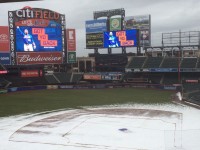
Am I the only one that finds it incredibly fitting that Yoenis Cespedes is being introduced during a rainy day? Remember, it might’ve been a rainy day that brought him here in the first place.
Roughly half a year ago, there was some hope in the Mets season. The team had just acquired Tyler Clippard, Kelly Johnson, and Juan Uribe. Michael Conforto was up with the team and producing well ahead of schedule. Travis d’Arnaud was soon to return. While Mets fans had seen some bad baseball for far too long, things were seemingly getting much better. Then disaster struck.
There was the inexplicable drama surrounding the failed Carlos Gomez trade. Wilmer Flores was left standing on the field crying. Then we discover the trade didn’t happen. The Mets say Gomez failed a physical. The Brewers said the Mets wanted money in the deal. With all that hovering, the Mets took the field for a rainy day game. They had a 7-1 lead going into the seventh, and a 7-5 lead heading into the ninth. The Padres had two outs and Jeurys Familia had an 0-2 count on Derek Norris.
The heavens opened causing the umps to call a rain delay for a game that could’ve ended with one more pitch. The delay nearly lasted an hour. When they game resumed Familia allowed a single to Norris, another single to Matt Kemp, and then a three run homer to one-time trade target Justin Upton. After another rain delay of around two and a half hours, the game resumed seeing the Mets go down meekly 1-2-3 in the ninth. Whatever good feelings and momentum in the season was there, it was seemingly washed away. The fans were angry.
The rains eventually cleared. There would be a new day both literally and metaphorically when the Mets pulled the trigger on the trade for Yoenis Cespedes. Sure the Mets win the NL East without him, but man, the 2015 season had a different feel to it when he came on board. It was a fun run, and now he’s back. We’re ready for another ride.
But first, he’s going to be re-introduced to the fans on a rainy day. Seeing how it was a rainy day that brought him here, I wouldn’t have it any other way.
Welcome back Cespedes.
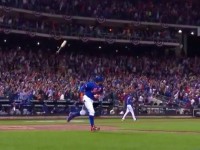
What I’ve found is most of the people that support the Yoenis Cespedes trade is he transformed the offense, and he was the reason the Mets won the NL East. Other people say while Cespedes was great with the Mets, there were other more important factors helping the Mets win the NL East. These arguments rest upon the Mets getting healthy and a weak August schedule.
I think the best way to look at this is just to present the facts. I’m presenting them unadulterated and without comment. Before presenting them, remember that Cespedes’ first game with the Mets was 8/1.
Pre-Cespedes Record: 53 – 51
Post-Cespedes Record: 37 – 21
In the same time frame, here is the Nationals record:
Pre-Cespedes Record: 54-47
Post-Cespedes Record: 29-32
Mets Opponents Combined Win Percentage and Mets Record by Month:
April Opponents .458 Mets 15-8
May Opponents .510 Mets 13-15
June Opponents .483 Mets 12-15
July Opponents .537 Mets 13-12
August Opponents .480 Mets 20-8
September/October Opponents .458 Mets 17-14
Here is the Mets and Nationals records and position in the standings at the end of every month:
April
Mets 15-8
Nats 10-13 (5.0 games back)
May
Nats 28-22
Mets 28-23 (0.5 games behind)
June
Nats 43-34
Mets 40-38 (3.5 games behind)
July
Nats 54-47
Mets 53-50 (2.0 games behind)
August
Mets 73-58
Nats 66-64 (6.5 games behind)
September/October
Mets 90-72
Nats 83-79 (7.0 games behind)
Overall, the Mets went from 2.0 games behind heading into August to 6.5 games up at the end of the month. As stated above the Mets record in August was 20-8 against opponents with a .480 winning percentage. The Nationals went 12-17 against opponents with a .490 winning percentage. Aside from the records, here is some additional information to consider:
Dates Key Players Came off the DL for good (by first game played after activation):
Travis d’Arnaud July 31st
Daniel Murphy June 30th
David Wright August 24th
Michael Cuddyer August 11th
Here are some other key dates from the 2015 season to consider:
July 24 – Michael Conforto called up from AA
July 24 – Mets trade for Juan Uribe and Kelly Johnson
July 27th – Mets trade for Tyler Clippard
July 30 – John Mayberry, Jr. released
July 31 – Mets trade for Cespedes
August 1 – Cespedes plays first game with the Mets
Again, I’m making no comment on any of this information. It’s being presented to review it and process it. Upon reviewing the information, does your judgment on how Cespedes impacted the Mets change or remain the same?
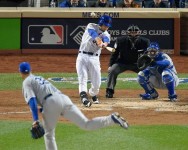
There are many out there calling the Mets offseason a success so far. Personally, I don’t see it. Yes, I know the offseason isn’t over, but we’re also pretty sure the Mets aren’t replacing Yoenis Cespedes‘ bat.
Overall, the Mets as constituted now are not better than the team that lost the World Series. Here was the lineup for the team that just lost the World Series, with their respective WAR from the 2015 season:
- Curtis Granderson 5.1
- David Wright 0.5
- Daniel Murphy 1.4
- Yoenis Cespedes 6.3
- Lucas Duda 3.0
- Travis d’Arnaud 1.7
- Michael Conforto 2.1
- Wilmer Flores 0.8
Combined 20.9
If the Mets make no other additions this offseason, which still remains a possibility, here’s the Mets 2016 starting lineup with the player’s WAR from last year.
- Curtis Granderson 5.1
- Neil Walker 2.4
- David Wright 0.5
- Lucas Duda 3.0
- Asdrubal Cabrera 1.7
- Michael Conforto 2.1
- Travis d’Arnaud 1.7
- Juan Lagares 0.6
Combined 17.1
On paper, barring any further additions the 2016 starting lineup is worse than the 2015 World Series team. This is despite how more “athletic” the Mets are in the middle infield. In response, the argument is the Mets are now deeper. Are they? Let’s compare the 2015 and 2016 benches.
Before comparing, it should be noted I’m going to use a traditional 13 position players and 12 pitchers split. That means I will have to eliminate once bench player from the 2015 Mets. I’m choosing to remove Kirk Nieuwenhuis from the roster as he was called up in September.
I’m also dropping Juan Uribe from the 2015 roster. When building a team, you’re going to want a backup shortstop. Uribe doesn’t fit the bill. Since Ruben Tejada was injured, and thus unavailable, I’m replacing him with Matt Reynolds, whom I’m assigning a 0.0 WAR since he didn’t play at all last year.
Here’s the modified 2015 World Series bench:
- Kevin Plawecki 0.9
- Matt Reynolds 0.0
- Michael Cuddyer 0.5
- Kelly Johnson 0.3
- Juan Lagares 0.6
Combined 2.3
Here’s the current bench, which would be subject to change with a free agent signing:
- Kevin Plawecki 0.9
- Wilmer Flores 0.8
- Ruben Tejada -0.1
- Kirk Nieuwenhuis 0.7
- Eric Campbell -0.5
Combined 1.8
Now to be fair, the 2016 bench will mostly likely not have Eric Campbell on the Opening Day roster. Eliminating his -0.5 would balance out these benches.
Here’s one big problem, if not Campbell then who? Let’s assume Mets fans get their way, and the team signs Denard Span. Span had a 0.7 WAR last year. Yes, that’s the same as Kirk’s. Slotting Span into the everyday lineup has this effect:
- Starting Lineup WAR increased from 17.1 to 17.2
- Bench WAR decreased from 1.8 to 1.7
- Eric Campbell or Kirk Nieuwenhuis is still on the Opening Day roster
Now, first counter-argument will be the offseason isn’t over, so the Mets can still make additional moves. Currently, without any other moves, the Mets payroll stands around $105.7 million. Let’s assume for arguments sake, the Mets have around $10 million to spend. With that $10 million, the Mets are looking to add a reliever, a CF, and another bat.
Span is estimated to receive about $12 million a year. Well, that blows the whole budget. Even assuming the Mets could get Span for less, they’re not going to have enough money for a reliever and another bat after that. So again, chances are either Campbell or Kirk will be in the Opening Day roster.
The next counter-argument is last year’s WAR doesn’t account for full years from Wright, d’Arnaud, or Conforto. This point-of-view is acceptable. However, you also have to acknowledge Granderson may be due for a regression at 35 years of age with a repaired torn ligament in this thumb. Also, based upon their histories, you can’t rely on Wright or d’Arnaud to last a full season. Essentially, while you can expect some players to improve or play more often, you can expect others to regress and/or suffer injuries.
Overall, the Mets still might be able to win the NL East and return to the playoffs in 2016. They will do so because of their pitching. However, objectively speaking, you have to admit the 2016 Mets are and will be weaker than the 2015 Mets team that lost the World Series.
That is unacceptable.
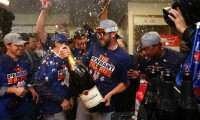
You know Jon Niese never made it easy, did he? He was at times cantankerous. He seemingly always had a chip on his shoulder. He was no different on his way out the door:
Jon Niese: “I’m sure what I’ll appreciate more than anything is the way (#Pirates) play defense. I’m looking forward to that.”
— RobBiertempfel (@RobBiertempfel) December 10, 2015
Was it a shot at the Mets for trading him? Who knows? He once fought with Terry Collins in the dugout (not physically). He blamed a poor start on Travis d’Arnaud. Personally, I’d like to think this was all part of him being a fiery competitor. I didn’t always think this way. My opinion changed when he approached Collins to join the bullpen.
The story with Niese was he was born on the date the Mets last won the World Series. He came to the team and offered to do whatever it took to help them win another. He acted like a player who lived through the last collapse and finally got a chance to pitch in the postseason. I think most Mets fans thought he would whine and demand the ball. Instead, he just said he wanted to help.
He was terrific. He helped the Mets solve an issue they had all year. They never had a lefty in the pen. It became Niese, and he pitched well. Other than this run, Niese was known for his attitude, troubles in the sixth inning, and Carlos Beltran paying for his nose job. Now, he’s also known for Celebratory Slip ‘N Slides.
For me, I remember Niese for this blog’s first big break. The piece about the birth of Niese’s child got this blog noticed by the great Faith and Fear in Flushing with a link on the website. If you’ve come across this site, please repay the favor by buying his new book. You know it’ll be terrific, so just go ahead and buy it. I digress.
Anyway, part of the success of this blog is attributable to Niese. Part of the run to the World Series was attributable to Niese. These may be two things I never thought would come true, but they did. Now Niese is in Pittsburg with a pitching coach that’s really going to turn his career around, and it’s quite possible he’ll make the Mets look bad for giving up on him.
In a small way, I hope he does. With his pitching this postseason, he earned well wishes from Mets fans. It’s great that he’s closer to his boyhood home in Ohio. Overall, i wish him and his growing family well.
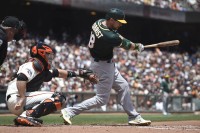
Like everyone else, I’ve gone on and on about Ben Zobrist, Daniel Murphy, and the whole second base situation. Now, Zobrist seems to be close to making a decision, and many have speculated he may just become a Met. Honestly, why would he do that?
First and foremost, the obvious reason is the Mets may be offering the most money, which frankly, is a rarity in these situations. Other than that, I can only think of five other reasons Zobrist would want to be a Met:
Sure, the Mets are an NL East team closer to Zobrist’s Tennessee home than an NL West team, and they intend to put him at second where he prefers. The Mets did win the pennant establishing they are ready to win now. There are other nice pieces on the team, but they carry question marks: Curtis Granderson (age), David Wright (back), Travis d’Arnaud (injury history), and Juan Lagares (right handed pitching).
Zobrist would be joining a team losing its #3 and #4 hitters and replacing them both with just him. The Mets also have a bottom third payroll with apparently not much room to increase it despite the additional playoff revenue. Sure, every team has problems, but the other two teams interested in Zobrist will go out and spend. The other options may be more attractive than the Mets.
Washington Nationals
Keep in mind, the Nationals remain a dangerous team. They still have Max Scherzer (who no-hit the Mets) and Stephen Strasburg headlining the rotation. Bryce Harper took his game to the next level and won the MVP award. Anthony Rendon is a very good young player, who may very well be a Top 5 Third Baseman. There are exciting young players like Michael Taylor and Trea Turner.
The Nationals also had the third highest payroll in the sport last year (no one was going higher than the Dodgers and Yankees). They already addressed their biggest problem from last year by firing Matt Williams and hiring Dusty Baker. Dusty has his flaws, but he always seems to get the most out of his players. Lastly, the Nationals have already stated they want Zobrist to play second base.
Overall, the Nationals are still poised to win a lot of games next year, have a lot of terrific pieces, and have the ability to spend the money necessary to be a contender to win the World Series.
San Fransicso Giants
Speaking of contenders to win the World Series, next year is an even numbered year, which means the Giants are due to win the World Series. The Giants were the other team that no-hit the Mets this year.
Overall, there is a lot to like with the Giants. Madison Bumgarner is the best money pitcher in the sport. Buster Posey might just be the best position player in the NL (if it’s not Harper). Bruce Bochy is the best manager in all of baseball as well. There’s also the matter of the Giants hitting coach, who has been doing wonders with some of their younger players.
Gold Glover Brandon Crawford has increasingly hit for more power. Joe Panik has become an underestimated high OBP second baseman (sound familiar?). Matt Duffy showed increased power while finishing second in the Rookie of the Year voting.
Seriously, so what if the Giants want Zobrist to play LF? This is a team built to contend for the long and short team. They also have the sixth highest payroll in baseball. This team has an eye for young talent and is willing to spend to either keep their players or bring in new ones to fill their holes. The Giants have truly created a wonderful organization.
The Decision
If you’re being honest with yourself, and the money is even, why would you pick the Mets? They don’t have the wherewithal to spend the other teams do. The other teams have been addressing needs this offseason, while the Mets have yet to bring someone in to improve their team. It’s still debatable if the Mets have enough money to make another significant move if Zobrist becomes a Met.
If it was me, I’d always pick the Mets because I’m a die hard fan. However, if we’re looking at these teams on paper, I’m not sure the Mets are the most attractive option for any free agent. You have to know that going to the Mets may mean you’re going to be the only major league signing. That’s been pretty much true of ever offseason for the Sandy Alderson regime.
Given the fact that Zobrist wants to win, play second, and stay closer to home, why shouldn’t he pick the Nationals? They have pitching and an arguably better lineup then the Mets. They also have the ability to spend more money than the Mets.
While I would always choose to be a Met, if I’m being honest, a sure with no such loyalty could/should choose differently.
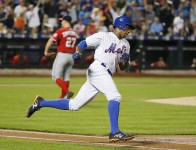
At this point, I don’t know if any fan can honestly tell you what the Mets will do this offseason. I wouldn’t be surprised if they make no major additions. If they don’t, the Mets should still be favorites to repeat as NL East Champions. The main reason is an already weak NL East keeps getting worse.
The Braves major offseason addition was to re-sign A.J. Pierzynski. Other than that, they traded away their young SS Andrelton Simmons. They’re threatening to do the same with Freddie Freeman.
The Phillies have made no major moves, and do not appear to be doing so. Sure, they may have cleaned up the front office, but that will not have any impact upon their 2016 season.
The Marlins brought in a very average manager in Don Mattingly, and then immediately threatened to get rid of anyone if any value. Whether it’s Jose Fernandez and his hoodies or Marcel Ozuna and his accumulation of service time, the they’re looking to get rid of anyone not named Giancarlo Stanton or Ichiro Suzuki.
Then there are the Nationals, who just lost Jordan Zimmermann in free agency. I’m not sure how they replace him with their payroll issues. Essentially, they’re relying on Anthony Rendon being healthy, and the switch from Matt Williams to Dusty Baker vastly improving a team losing its CF and SS. It’s possible they will be better, but that’s a lot to ask considering Bryce Harper was the MVP, and Max Scherzer had a Cy Young caliber season.
The Mets have holes, but they return a young rotation poised to be deeper and better. They’ll presumably have a full year of Travis d’Arnaud, Michael Conforto, and David Wright. At the end of the day, it just might be enough offense to offset the losses of Yoenis Cespedes and Daniel Murphy. Ultimately, it may not matter with the NL East regressing.
The Mets need to just play to their potential to repeat in the NL East for the first time in their history.
